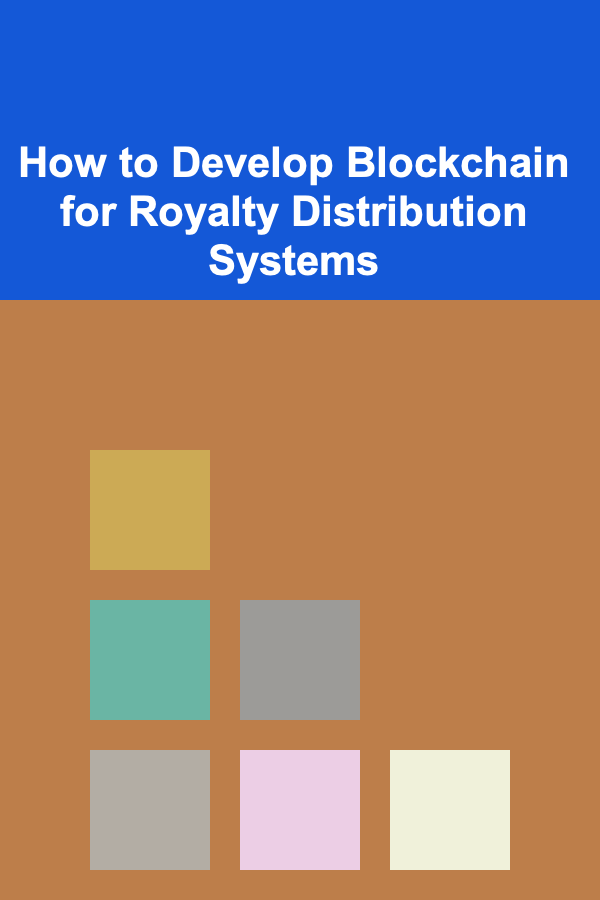
How to Develop Blockchain for Royalty Distribution Systems
ebook include PDF & Audio bundle (Micro Guide)
$12.99$7.99
Limited Time Offer! Order within the next:

The world of digital content has rapidly evolved with the rise of online streaming platforms, digital media distribution, and intellectual property licensing. As the volume of digital content continues to grow, ensuring fair and efficient royalty distribution to creators, publishers, and other stakeholders has become an increasingly complex task. Traditionally, royalty systems have been prone to delays, lack of transparency, and inefficiencies. However, blockchain technology offers a promising solution to these challenges.
Blockchain, with its decentralized nature, transparency, and immutability, provides a powerful tool to address the issues inherent in royalty distribution systems. This article explores how to develop a blockchain-based system for royalty distribution, detailing the steps involved, potential challenges, and the benefits this innovation can offer.
Understanding the Traditional Royalty Distribution System
Before diving into the potential of blockchain, it's essential to understand how the traditional royalty distribution system works and why it's often inefficient.
A typical royalty distribution system involves multiple parties: content creators, distributors, publishers, and collecting societies. Here's how it typically works:
- Content Creation: A creator (musician, artist, author, etc.) produces a piece of content (song, book, artwork, etc.).
- Licensing: The creator or their representative licenses the content to various platforms, such as streaming services, record labels, or broadcasters.
- Usage Tracking: The platform tracks the usage of the content (e.g., streams, sales, airplay).
- Royalty Calculation: The platform calculates the royalties owed to the creator based on usage data, often using complex algorithms and formulas.
- Payment Distribution: Finally, the platform or a third-party organization (such as a collecting society) distributes the royalties to the creators and other stakeholders (such as publishers, producers, etc.).
This system often faces several challenges:
- Lack of Transparency: Creators often don't have visibility into how royalties are calculated or when they are paid.
- Delays: Payments may be delayed due to the involvement of multiple intermediaries and complex financial processes.
- Inefficiency: The involvement of various middlemen and administrative costs leads to a reduction in the amount of royalty creators ultimately receive.
- Error-Prone: Manual data entry and record-keeping increase the chances of errors in royalty calculations and payments.
Blockchain technology can revolutionize this system by eliminating many of these inefficiencies.
Blockchain Technology: A Brief Overview
Blockchain is a distributed ledger technology that enables secure, transparent, and tamper-proof record-keeping. At its core, blockchain consists of blocks (which store data) linked together in a chain. Each block contains a record of transactions, and once a block is added to the chain, it cannot be altered or deleted. This immutability ensures that the data is secure and transparent.
Key characteristics of blockchain include:
- Decentralization: There is no central authority controlling the network. Instead, transactions are verified by a network of nodes (computers), which ensures the system is resilient to attacks.
- Transparency: Every participant can view the transactions recorded on the blockchain, providing greater visibility into the process.
- Immutability: Once data is recorded on the blockchain, it cannot be changed, making the system highly secure and trustworthy.
- Smart Contracts: These are self-executing contracts with the terms of the agreement directly written into code. Smart contracts can automate processes like royalty calculations and distribution.
By leveraging these characteristics, blockchain can address the key challenges faced by traditional royalty distribution systems.
Benefits of Blockchain for Royalty Distribution
1. Transparency and Trust
Blockchain's transparency allows all participants in the royalty distribution process (creators, publishers, distributors, etc.) to view the transactions related to their royalties. This transparency builds trust, as creators can track exactly how their content is being used and how their royalties are being calculated and distributed.
By using smart contracts, all terms related to the royalty distribution are stored on the blockchain, and no party can alter the terms after they've been agreed upon. This reduces the chances of disputes and fosters trust among all stakeholders.
2. Efficiency and Speed
One of the major advantages of blockchain is its ability to automate many processes that are traditionally manual. With smart contracts, the entire royalty distribution process can be automated. Once a usage event is recorded (e.g., a song is streamed), the smart contract can automatically calculate the royalties owed, deduct any fees or commissions, and transfer the payments to the creators and other stakeholders in real-time.
This drastically reduces the time and cost involved in the royalty distribution process, ensuring that creators are paid faster and with fewer intermediaries.
3. Reduced Costs
By eliminating intermediaries and automating the royalty calculation and distribution process, blockchain can significantly reduce the administrative costs associated with royalty distribution. In traditional systems, multiple parties (such as collecting societies, publishers, and distributors) are involved, each taking a cut of the royalties before passing them on to the creator. Blockchain can cut out many of these intermediaries, ensuring that a higher percentage of the royalty payment goes directly to the creator.
4. Security and Immutability
Blockchain's immutability ensures that once a transaction is recorded, it cannot be altered or tampered with. This is particularly important in royalty distribution, where discrepancies or fraudulent activity can lead to significant financial loss for creators. With blockchain, creators can be confident that their royalties will be paid accurately and securely, and that the usage data recorded is reliable.
5. Global Accessibility
Blockchain operates on a decentralized network, meaning it is accessible from anywhere in the world. This can benefit creators who may be based in different countries and are dealing with international distribution platforms. Blockchain eliminates the need for cross-border transactions and currency conversions, as the entire process is streamlined and can be conducted in a single system, making it easier for creators to receive royalties from multiple sources.
How to Develop a Blockchain-Based Royalty Distribution System
Developing a blockchain-based royalty distribution system involves several steps, from understanding the stakeholders and requirements to implementing the technology and ensuring its scalability. Below is a step-by-step guide to developing such a system.
Step 1: Identify Stakeholders and Define Requirements
The first step in developing a blockchain-based royalty distribution system is to identify all the stakeholders involved. These may include:
- Content Creators: Musicians, authors, filmmakers, artists, etc.
- Publishers: Companies or individuals who own the rights to the content.
- Distributors: Platforms that distribute the content, such as streaming services, record labels, or digital marketplaces.
- Collecting Societies: Organizations that collect and distribute royalties on behalf of creators.
Each stakeholder will have different requirements, so it's important to clearly define the roles, rights, and obligations of each participant in the system. You will also need to determine how royalties will be calculated, the percentage splits for each stakeholder, and how disputes will be resolved.
Step 2: Choose a Blockchain Platform
The next step is to choose a blockchain platform that suits your needs. Some popular blockchain platforms for building decentralized applications (dApps) include:
- Ethereum: Known for its support of smart contracts and decentralized applications. Ethereum's well-established ecosystem and security features make it a popular choice.
- Hyperledger Fabric: A permissioned blockchain platform designed for enterprise use, offering privacy and scalability.
- Stellar: A blockchain platform designed for fast and low-cost cross-border payments, making it a good choice for royalty distribution.
When choosing a platform, consider factors like transaction speed, cost, scalability, and support for smart contracts.
Step 3: Develop Smart Contracts
Smart contracts are the backbone of a blockchain-based royalty distribution system. These contracts automatically execute the terms of the agreement when predefined conditions are met. For example, a smart contract can be written to automatically calculate royalties based on streaming data and distribute payments to creators and stakeholders.
You will need a development team with experience in blockchain programming languages such as Solidity (for Ethereum) or Chaincode (for Hyperledger) to write these contracts. The contracts should include provisions for:
- Royalty Calculation: Define how royalties are calculated based on usage data (e.g., per stream, per download).
- Revenue Splits: Specify how royalties are divided between creators, publishers, and distributors.
- Payments: Ensure the contract triggers automatic payments to stakeholders.
- Dispute Resolution: Include mechanisms for handling disputes, such as arbitration or appeals processes.
Step 4: Integrate with Data Sources
In order for the system to accurately track usage data (e.g., the number of streams or sales of content), the blockchain system must integrate with external data sources. This might involve working with streaming platforms, digital marketplaces, or other distributors to securely input usage data into the blockchain.
One way to achieve this is by using oracles---trusted third-party services that feed real-world data into the blockchain. For example, an oracle could be used to report the number of times a song is streamed on a platform, triggering the smart contract to calculate and distribute the royalties.
Step 5: Develop the User Interface
To make the blockchain system user-friendly, you will need to develop a front-end interface that allows stakeholders to interact with the platform. This might include dashboards for creators to view their earnings, track content usage, and manage their settings. Publishers and distributors may also need access to reporting tools and analytics.
The interface should be simple, intuitive, and accessible to users with varying levels of technical expertise. Consider using frameworks like React or Angular to build responsive and interactive user interfaces.
Step 6: Test and Deploy the System
Once the system is developed, it's crucial to thoroughly test it to ensure it functions as expected. This includes testing smart contracts, verifying the accuracy of royalty calculations, ensuring that payments are distributed correctly, and checking the security of the platform.
After successful testing, deploy the system to a public or private blockchain, depending on your needs. It's important to ensure the system is scalable and can handle a high volume of transactions, especially if it is intended to support a large number of users.
Step 7: Ongoing Maintenance and Updates
Blockchain-based systems require ongoing maintenance to ensure they remain secure, efficient, and up-to-date with changing regulations or industry standards. This may include updating smart contracts, adding new features, or addressing any issues that arise.
You will also need to monitor the system for performance, conduct regular security audits, and engage with stakeholders to ensure the system continues to meet their needs.
Challenges and Considerations
While blockchain offers numerous benefits for royalty distribution, there are also challenges to consider:
- Scalability: High transaction volumes could pose challenges for blockchain networks, particularly public blockchains like Ethereum.
- Regulatory Compliance: Different countries have varying laws regarding intellectual property and digital payments. Ensuring the system complies with all applicable regulations is crucial.
- Adoption: Getting stakeholders (particularly traditional distributors and publishers) to adopt blockchain-based systems can be challenging, as it requires significant changes to their existing processes.
- Data Privacy: While blockchain is transparent, it may not be suitable for storing sensitive information without additional privacy features.
Conclusion
Blockchain technology has the potential to revolutionize royalty distribution by addressing the inefficiencies, lack of transparency, and security concerns of traditional systems. By automating the royalty calculation and distribution process through smart contracts, blockchain can ensure faster, more transparent, and more efficient payments for creators and other stakeholders. However, building a blockchain-based royalty distribution system requires careful planning, collaboration with stakeholders, and attention to regulatory compliance.
The future of royalty distribution is likely to be decentralized, transparent, and driven by blockchain innovation, creating a more equitable and efficient system for digital content creators worldwide.

How to Create a Fun DIY Craft Station for Your Party
Read More
How to Make Your Rental Property Stand Out in a Competitive Market
Read More
How to Use Deep Learning to Build Profitable AI Solutions
Read More
How to Use Pegboards for Hanging Instruments and Gear
Read More
Research Scientist's Handbook: Best Practices for Managing Research Projects and Collaborations
Read More
Why A Tidy Garden Shed Enhances Your Gardening Experience
Read MoreOther Products

How to Create a Fun DIY Craft Station for Your Party
Read More
How to Make Your Rental Property Stand Out in a Competitive Market
Read More
How to Use Deep Learning to Build Profitable AI Solutions
Read More
How to Use Pegboards for Hanging Instruments and Gear
Read More
Research Scientist's Handbook: Best Practices for Managing Research Projects and Collaborations
Read More